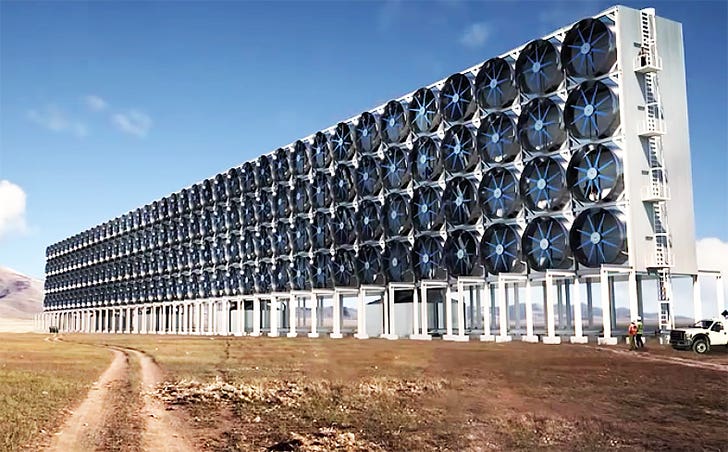Groundbreaking Direct Air Capture Project Takes On Climate Change in Texas
Direct Air Capture (DAC) involves enormous fans that inhale vast quantities of air, aiming to filter out the climate-aggravating carbon.

[Sept. 28, 2023: Staff Writer, The Brighter Side of News]
Direct Air Capture (DAC) involves enormous fans that inhale vast quantities of air, aiming to filter out the climate-aggravating carbon. (CREDIT: Carbon Engineering)
In the midst of western Texas's arid landscape emerges a groundbreaking endeavor: the world's largest project to extract carbon dioxide (CO2) from the atmosphere.
This monumental undertaking, often touted as a pivotal strategy in the battle against climate change, has garnered support from the Biden administration, even as detractors claim it's a diversion backed by the fossil fuel industry.
Direct Air Capture: A Rising Hope
Direct Air Capture (DAC) involves enormous fans that inhale vast quantities of air, aiming to filter out the climate-aggravating carbon. In June, the $1 billion "Stratos" project was inaugurated in Ector County, Texas, and its vision is ambitious: by 2025, remove 500,000 tons of CO2 annually.
Related Stories
Spanning 65 acres, the Stratos site will be a sprawling network of pipes, structures, and fans designed to meticulously clean the air of CO2, then safely inject the captured carbon deep into the earth's crust.
Drawing parallels to the historic Apollo 13 moon mission, Lori Guetre, Carbon Engineering's vice-president, during the groundbreaking event said, “This time the Earth has some serious complications, and it needs the brightest minds.” She emphasized the weight of the world's expectations, adding, “the world is watching and counting on us ... The team’s will to overcome is quiet, steady, and unwavering.”
DAC Industry Gets a Boost
In a significant move to champion DAC, President Joe Biden’s Department of Energy announced a $1.2 billion fund to establish two DAC hubs in Texas, aiming to extract over 2 million tons of CO2 collectively. This is a part of a broader $3.5 billion strategy to create a viable market for carbon removal. "Crucial to tackling climate change," as described by Jennifer Granholm, the US secretary of energy.
This commitment marks a dramatic shift for an industry that, despite the hope and financial backing, is still in its embryonic stages, struggling to prove its potential in addressing the escalating climate crisis.
Erin Burns, executive director of Carbon180, an NGO focusing on carbon-removal options, voiced the general optimism: “It’s an extraordinarily big moment for carbon removal right now and for direct air capture in particular.”
Yet, the optimism is not universally shared. Critics argue that DAC could be a costly detour from immediate emission reduction needs or even a strategic ploy by the fossil fuel industry to uphold their current polluting status. Notably, the Stratos project's principal owner is Occidental Petroleum, a major American oil corporation, which recently acquired Carbon Engineering for $1.1 billion.
“We believe that our direct capture technology is going to be the technology that helps to preserve our industry over time,” stated Vicki Hollub, Occidental’s chief executive.
This dual-role of Occidental, capturing CO2 while also leveraging the extracted carbon to further oil extraction, raises eyebrows and concerns among climate advocates.
First large-scale Direct Air Capture (DAC) plant in Ector County, Texas. (CREDIT: Occidental Petroleum)
Jonathan Foley, executive director of Project Drawdown, expressed his reservations: “We are going to pay an oil company to pump crap out of the ground and then pay them to put some back in – it’s plainly obvious this isn’t a climate solution.”
The Carbon Equation and the Way Forward
Current human activities, mostly through burning fossil fuels, emit around 36 billion tons of CO2 annually. Given the trajectory of emissions and the dire warnings from climate scientists, drastic cuts are needed to avoid catastrophic climate repercussions.
A view of a computer-rendered image of Climeworks' Mammoth direct air capture plant. (CREDIT: Climeworks)
As per the UN's Intergovernmental Panel on Climate Change (IPCC), to avoid surpassing 2C of warming, up to 10 billion tons of CO2 might need to be extracted annually by 2050. This points towards a pressing need for DAC, despite it still being in nascent stages.
While direct air capture alone may not be the silver bullet, its potential can't be ignored. "It's about investing in a portfolio of carbon-removal solutions," said Burns, emphasizing the pressing need to act swiftly in our collective fight against climate change.
For more green news stories check out our Green Impact section at The Brighter Side of News.
Note: Materials provided above by The Brighter Side of News. Content may be edited for style and length.
Like these kind of feel good stories? Get the Brighter Side of News' newsletter.
Joseph Shavit
Head Science News Writer | Communicating Innovation & Discovery
Based in Los Angeles, Joseph Shavit is an accomplished science journalist, head science news writer and co-founder at The Brighter Side of News, where he translates cutting-edge discoveries into compelling stories for a broad audience. With a strong background spanning science, business, product management, media leadership, and entrepreneurship, Joseph brings a unique perspective to science communication. His expertise allows him to uncover the intersection of technological advancements and market potential, shedding light on how groundbreaking research evolves into transformative products and industries.



